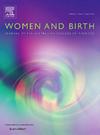Implementability of contraceptive implant insertions during midwife postnatal home visits: an exploratory qualitative study
IF 4.1
2区 医学
Q1 NURSING
引用次数: 0
Abstract
Problem
Many women lack access to contraception information and services during pregnancy and postnatally and are at risk of unintentionally falling pregnant again soon after birth.
Background
Contraception enables women to attain their desired number and spacing of births. Better access to postpartum contraception is critical for informed decision-making, higher uptake and improved health outcomes. Home-based provision of the contraceptive implant may contribute to increasing access.
Aim
To explore the views of midwives on the implementability of midwives providing contraceptive implants during postnatal home visits
Methods
We conducted an exploratory qualitative interview study with 21 midwives. Reflexive thematic analysis was used to construct themes.
Findings
Home implant insertions were seen as generally acceptable and potentially feasible. Midwives’ primary concerns related to workload and scheduling, although most felt this could be manageable, particularly in continuity models. Two factors to promote implementability included i) enhanced ‘contraception conversations’ in maternity settings, and ii) strong leadership and support, including a policy and training framework, opportunities for practice, and consideration of workload.
Discussion
Midwives felt home insertions would be well-suited to continuity care models. Although this may be a beneficial starting point, it means key groups of women who would also benefit from contraception may be missed.
Conclusion
Midwives viewed provision of home implant insertions as generally acceptable and potentially feasible, in the context of early and ongoing contraception conversations and proper planning and support. Further research trialling implant insertions during midwife postnatal home visits is warranted to determine feasibility and acceptability in real settings.
助产士产后家访期间植入避孕药具的可实施性:一项探索性质的研究
许多妇女在怀孕期间和产后缺乏获得避孕信息和服务的途径,并有在出生后不久无意中再次怀孕的危险。避孕使妇女能够达到她们想要的生育数量和生育间隔。更好地获得产后避孕对于知情决策、提高使用率和改善健康结果至关重要。家庭提供避孕植入物可能有助于增加获得机会。目的探讨助产士对产后家访中助产士提供避孕植入物可实施性的看法。方法对21名助产士进行探索性质的访谈研究。反身性主位分析用于构建主位。家庭植入被认为是普遍可接受的和潜在可行的。助产士的主要担忧与工作量和日程安排有关,尽管大多数人认为这是可以管理的,特别是在连续性模式中。促进可实施性的两个因素包括:1)在产妇环境中加强“避孕对话”;2)强有力的领导和支持,包括政策和培训框架、实践机会和工作量考虑。助产士认为家庭插入将非常适合连续性护理模式。虽然这可能是一个有益的起点,但这意味着可能会错过同样受益于避孕的关键女性群体。结论助产士认为,在早期和持续的避孕对话以及适当的计划和支持的背景下,提供家庭植入物插入通常是可接受的,并且可能是可行的。进一步的研究在助产士产后家访期间试验植入物插入是有必要的,以确定在现实环境中的可行性和可接受性。
本文章由计算机程序翻译,如有差异,请以英文原文为准。
求助全文
约1分钟内获得全文
求助全文
来源期刊

Women and Birth
NURSING-OBSTETRICS & GYNECOLOGY
CiteScore
7.20
自引率
13.20%
发文量
371
审稿时长
27 days
期刊介绍:
Women and Birth is the official journal of the Australian College of Midwives (ACM). It is a midwifery journal that publishes on all matters that affect women and birth, from pre-conceptual counselling, through pregnancy, birth, and the first six weeks postnatal. All papers accepted will draw from and contribute to the relevant contemporary research, policy and/or theoretical literature. We seek research papers, quality assurances papers (with ethical approval) discussion papers, clinical practice papers, case studies and original literature reviews.
Our women-centred focus is inclusive of the family, fetus and newborn, both well and sick, and covers both healthy and complex pregnancies and births. The journal seeks papers that take a woman-centred focus on maternity services, epidemiology, primary health care, reproductive psycho/physiology, midwifery practice, theory, research, education, management and leadership. We also seek relevant papers on maternal mental health and neonatal well-being, natural and complementary therapies, local, national and international policy, management, politics, economics and societal and cultural issues as they affect childbearing women and their families. Topics may include, where appropriate, neonatal care, child and family health, women’s health, related to pregnancy, birth and the postpartum, including lactation. Interprofessional papers relevant to midwifery are welcome. Articles are double blind peer-reviewed, primarily by experts in the field of the submitted work.
 求助内容:
求助内容: 应助结果提醒方式:
应助结果提醒方式:


